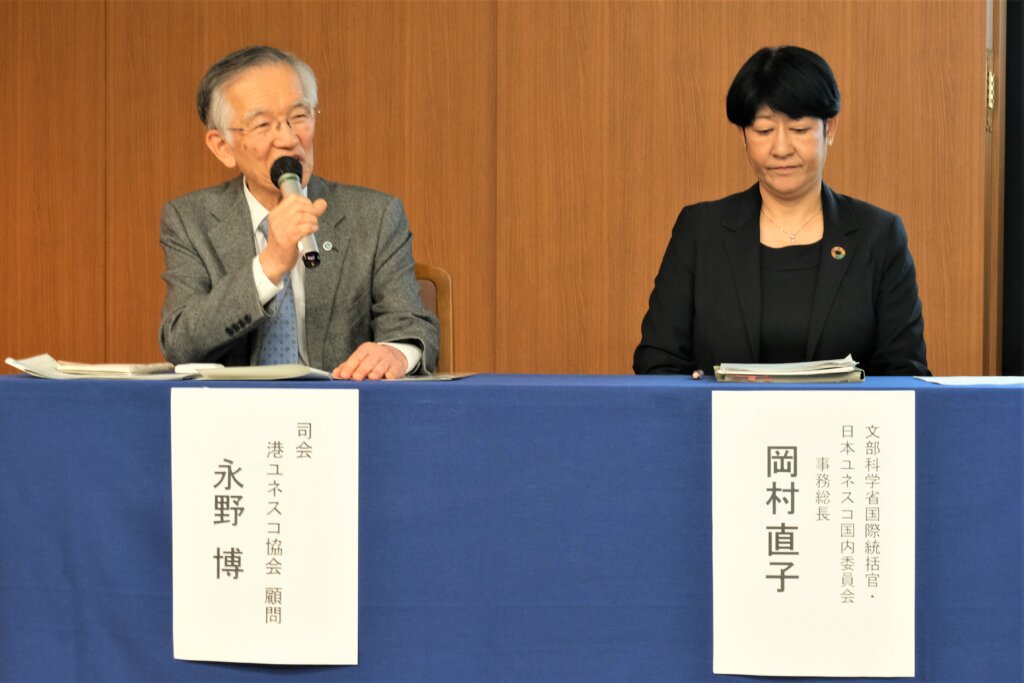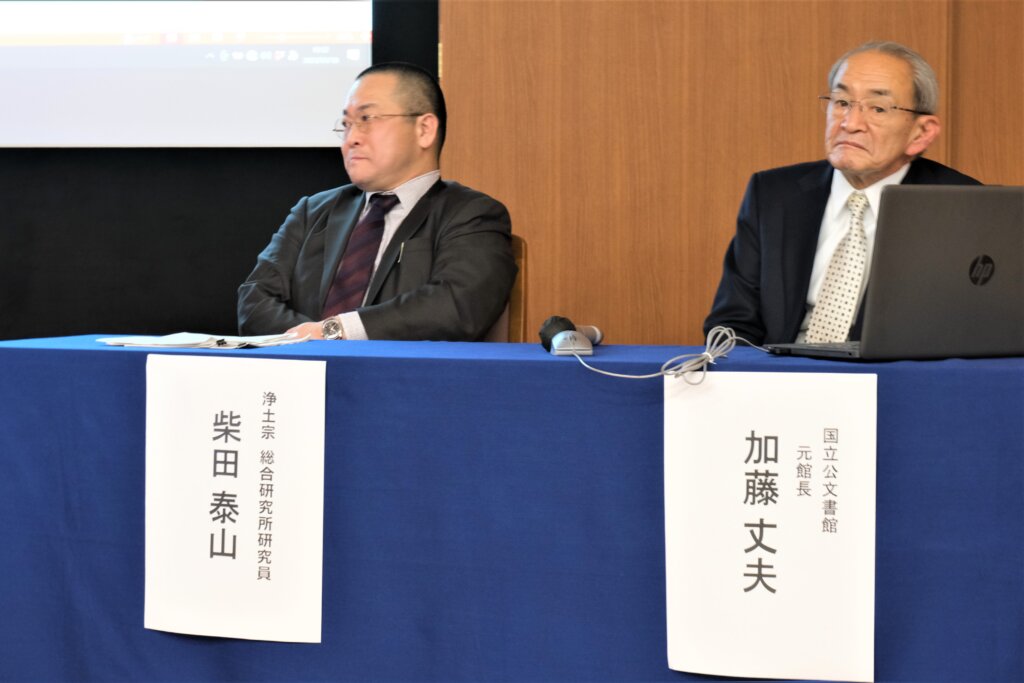UNESCO Memory of the World and the Zojoji Temple Scriptures
2022 Minato UNESCO Association Symposium
UNESCO Memory of the World and the Zojoji Temple Scriptures
Date & Time: 18:30 – 20:30, January 18, 2023
Venue: International House of Japan
Panelists: Mr. KATO Takeo, former Director, National Archives of Japan
Mr. SHIBATA Taisen, Researcher, Jodo-shu Research Institute
Coordinator: Mr. NAGANO Hiroshi, MUA President
Co-hosted by Minato City Board of Education
Cooperation from Daihonzan Zojoji Temple
Supported by: National Federation of UNESCO Association in Japan
Tokyo Metropolitan Liaison Council of UNESCO Associations
The “Three Daizokyo” scriptures, housed in the Minato City-located Daihonzan Zojoji Temple for over 400 years, were recently applied for the UNESCO Memory of the World. Taking this opportunity, we decided to hold this symposium. First, we had greetings from Ms. OKAMURA Naoko (Chief International Affairs Officer, Ministry of Education, Culture, Sports, Science and Technology), and Mr. URATA Mikio (Director, Minato City Board of Education). It was followed by the lectures by Mr. KATO Takeo and Mr. SHIBATA Taisen. Ms. OKAMURA also joined the panel discussion.


Lecture by Mr. KATO Takeo, former Director, the National Archives of Japan
Based on his career at the said national institute from 2013 to 2021, Mr. Kato talked about Japan’s efforts as a nation to dig out, preserve, manage and disclose its historically important archives. The followings are major points of interest from his talk:
■Definitions of basic words:
-Archives: Archives stand for public and private documents preserved as records. Majority of materials preserved in the archives house are public documents but private documents are also included. Therefore, a correct definition would be a “house for record materials.”
-Archivist: Experts engaged in archival work. There’s no equivalent Japanese word.
-The National Archives of Japan: The main building was constructed in 1972 in Kitanomaru Park in Chiyoda City. The Tsukuba branch building was constructed in 1998 in the City of Tsukuba. A total of about 1.5 million documents, as detailed below, are stored.
-Public historical archives: About one million documents (including 30 important cultural properties) are stored. Public documents, produced since the Meiji Restoration up to now, which relate to important national decision-makings such as the original promulgation copy of the constitution, law, imperial ordinance, cabinet ordinance, and diplomatic treaties. (Examples) The original of Japan’s constitution; The original of the rescript of the end of the war, which Emperor Showa read.
-Old documents and archives: About 50 documents:
・Documents possessed by the shogunate families, temples & shrines, court nobles and samurais in the pre-Edo period.(Examples) Azuma-kagami, Chinese Zenso-heiwa stories
・Documents either donated or deposited by individuals:
(Examples) SATO Eisaku’s diary; Heisei (Era) documents
■Roles of the national archives
1.Storage of public archives
Visitors will correctly understand the societal rules & regulations (including the constitution, laws, ordinances, etc.) which influenced people’s way of living and livelihood as well as the process of legislation.
2. Storage of historical materials
Visitors will understand the history and culture of their country and regions and thereby start to have pride and confidence as nationals and citizens. They will also acquire skills to think about the future. The UNESCO Memory of the World addresses the same objective.
■National efforts to enrich the national archives
1.Efforts to facilitate the objective of the National Archives Management Act (enforced in 2011)
We often hear about “archives,” in connection with scandals. This act facilitates the basic legal flow from the preparation, management, preservation, and disclosure of official documents.
2. Active collection of historical materials
In commemoration of the 150th anniversary of the Meiji Restoration, efforts have been underway to actively dig out and collect historically important materials, which have been dispersed nationwide, and turn them into digital format for the extensive use by citizens. Such materials include those historical documents which have been preserved, for example, in the temples & shrines, or in the attics of old houses of village headmen.
■Current status of the archives (1)
There are a total of 87 archival facilities nationwide as of July 2022. Details are as follows:
Prefectural: 42; Ordinance-designated cities: 10; Municipalities: 35
■Current status of the archives (2)
Compared with the counterparts in Europe and the U. S., Japan’s facilities and management of archives have lagged behind. There is an urgent need to strengthen their systems in both hardware and software.
Comparison between Japan and France:
Japan: The national archives of Japan (main building) was built in 1971. Staff: 200
France: The archival facility was built in 1790, the following year of the French Revolution.
Staff: 529.
■Challenges to be met for strengthening the archives (1)
1.Promotion of active archival collection
Digitalization would enable on-line operation. If you enter “National Archives of Japan Digital
Archives” on your home PC, for example, you can view about 20 important cultural properties.
2.Promotion of applications for the UNESCO World Heritage cultural assets registration
Japan is assisting in active unity to promote such efforts. Ideally, registration should be followed by a renewed erception of the value of historically important materials and by strengthened preservation systems. This is the No. 1 challenge for Japan.
■Challenges to be met for strengthening the archives (2)
Development of human resource who will be engaged in record management:
It’s necessary to increase the number of archivists. They are the key experts who protect culture with their steady and sober work. This is the No. 2 challenge. Their social status as experts should be established, with enriched study courses and public certification system.
Lecture by SHIBATA Taisen, researcher at the Jodo-shu Research Institute
Subject: Three kinds of Daizokyo scriptures possessed by Daihonzan Zojoji Temple
Mr. Shibata talked about the history and abstract of the scriptures, which are the principal texts of the Buddhist canon, as well as the aspirations of Tokugawa Ieyasu, who donated them, to promote Buddhist culture and world peace. The followings are summaries of major points:
■Daiden and Kyozo
Daiden is the main hall of Zojoji Temple. It was built during the latter half of the 1300’s. It flourished under the Tokugawa shogunate in Edo period. After the Meiji Restoration, it was marred by fires, earthquakes and air-raids. The architecture has paralleled the history of Tokyo and Minato City. Kyozo was built during the 1800’s. During the Edo period and thereafter, the said Daizokyo scriptures have been preserved in this facility.


■The three Daizokyo scriptures possessed by Zojoji Temple
①Sung version: Shikei-version Daizokyo scripture (total 5342 jo’s) newly printed during the Nan-so period (12th century) (photo shown below-left)
②Yuan version: Funeiji-version Daizokyo scripture (total 5228 jo’s) newly printed during the Nan-so period (13th century)
③Korai version: Korai-version Daizokyo scripture (total 1357 tablets) newly printed during Korea’s Korai period (13th century) (photo shown below-right)


■Tokugawa Ieyasu
Why are there three Daizo scriptures in Zojoji Tempe? Why did Ieyasu donate all three Daizokyo scriptures? Ieyasu thought one was not enough. With Zojoji as a center, he wished for peace,security and tranquil order of Edo, Japan and the world. From the Meiji Restoration and thereafter, Zojoji Temple has never let off these scriptures and preserved them strictly, with shogunate’s three-leaves crest stamped on them. During the Edo period, these scriptures were never opened public, under the careful management by Zojoji Temple. They coincide with the history of Zojoji Temple.
■What is written in Daizokyo scriptures?
During the Sung Dynasty in China, printing technology was established. That’s when the first Sung-version Daizokyo scripture was produced. Various papers, including Mahayana or Hinayana Buddhism-related scriptures, had been produced in India. The objective of Daizokyo scriptures was to bundle the whole set of such vast paper resources, in an effort to hand them down to posterity. The Daizokyo scripture is a series of Buddhist scriptures which store a wide variety of information, including nature, culture, performing arts, drugs, medical science, etc. of ancient India. Simply put, it is a compilation of the Oriental philosophy, wisdom and culture.
■Why were so many Daizo scriptures produced?
Various Daizokyo scriptures were produced in China during different periods from Sung dynasty to Quing dynasty. Production of Daizokyo scriptures represented the high level of cultural activities in the country, and the distribution of such scriptures symbolized cultural maturity. It’s a big burden to preserve even a single Daizokyo scripture so you can imagine how demanding it is for Zojoji Temple to possess and protect three Daizokyo scriptures
■Daizokyo scriptures are a foundation for modern Buddhist studies
The Taisho Shinshu Daizo scripture was produced with the three Daizokyo scriptures as the standard text. It is a must textbook for experts in Buddhist studies, and is regarded as the foundation for Buddhist studies worldwide,
■Digitalization
In 2024, Jodo-shu will observe the 850th anniversary since Honen Shonin, its founder, started the sect. To prepare for the milestone commemoration, digitalization of the three Daizokyo scriptures has been underway since 2017. In the future, you will be able to view all Korai, Sung and Yuan versions, once you log in “Taisho Shinshu Daizokyo scripture text database.” We plan to extend the availability of this service worldwide to facilitate future Buddhist/Buddhism studies and to thereby let the world know more about Oriental ideas, traditions and philosophy.
(MUA staff comments)
We had a total of 51 attendees. Active exchange of opinions was held during the panel discussion session following the lectures. Also, some participants engaged proactively in amicable conversation after the session. All attendees looked satisfied with the enlightening program.
(Written by Sato R., Chairperson, the International Science & Culture Committee, and translated by TANAHASHI S., the PR & Internet Committee)
